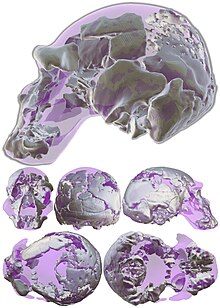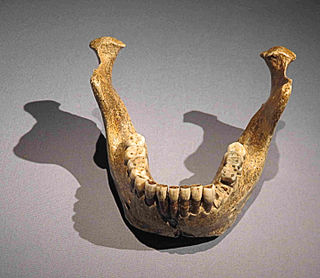
Homo heidelbergensis is an extinct species or subspecies of archaic human which existed during the Middle Pleistocene. It was subsumed as a subspecies of H. erectus in 1950 as H. e. heidelbergensis, but towards the end of the century, it was more widely classified as its own species. It is debated whether or not to constrain H. heidelbergensis to only Europe or to also include African and Asian specimens, and this is further confounded by the type specimen being a jawbone, because jawbones feature few diagnostic traits and are generally missing among Middle Pleistocene specimens. Thus, it is debated if some of these specimens could be split off into their own species or a subspecies of H. erectus. Because the classification is so disputed, the Middle Pleistocene is often called the "muddle in the middle".

Meganthropus is an extinct genus of non-hominin hominid ape, known from the Pleistocene of Indonesia. It is known from a series of large jaw and skull fragments found at the Sangiran site near Surakarta in Central Java, Indonesia, alongside several isolated teeth. The genus has a long and convoluted taxonomic history. The original fossils were ascribed to a new species, Meganthropus palaeojavanicus, and for a long time was considered invalid, with the genus name being used as an informal name for the fossils.
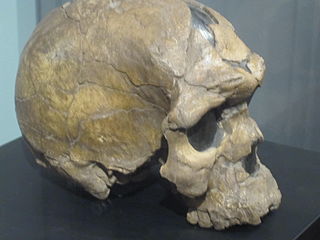
Herto Man refers to human remains discovered in 1997 from the Upper Herto member of the Bouri Formation in the Afar Triangle, Ethiopia. The remains have been dated as between 154,000 and 160,000 years old. The discovery of Herto Man was especially significant at the time, falling within a long gap in the fossil record between 300 and 100 thousand years ago and representing the oldest dated H. sapiens remains then described.

Homo rhodesiensis is the species name proposed by Arthur Smith Woodward (1921) to classify Kabwe 1, a Middle Stone Age fossil recovered from Broken Hill mine in Kabwe, Northern Rhodesia. In 2020, the skull was dated to 324,000 to 274,000 years ago. Other similar older specimens also exist.

Ceprano Man, Argil, and Ceprano Calvarium, is a Middle Pleistocene archaic human fossil, a single skull cap (calvarium), accidentally unearthed in a highway construction project in 1994 near Ceprano in the Province of Frosinone, Italy. It was initially considered Homo cepranensis, Homo erectus, or possibly Homo antecessor; but in recent studies, most regard it either as a form of Homo heidelbergensis sharing affinities with African forms, or an early morph of Neanderthal.

Aris Poulianos was a Greek anthropologist and archaeologist.

The Steinheim skull is a fossilized skull of a Homo neanderthalensis or Homo heidelbergensis found on 24 July 1933 near Steinheim an der Murr, Germany.
The Omo remains are a collection of hominin bones discovered between 1967 and 1974 at the Omo Kibish sites near the Omo River, in Omo National Park in south-western Ethiopia. The bones were recovered by a scientific team from the Kenya National Museums directed by Richard Leakey and others. The remains from Kamoya's Hominid Site (KHS) were called Omo I and those from Paul I. Abell's Hominid Site (PHS) were called Omo II.
Human taxonomy is the classification of the human species within zoological taxonomy. The systematic genus, Homo, is designed to include both anatomically modern humans and extinct varieties of archaic humans. Current humans have been designated as subspecies Homo sapiens sapiens, differentiated, according to some, from the direct ancestor, Homo sapiens idaltu.
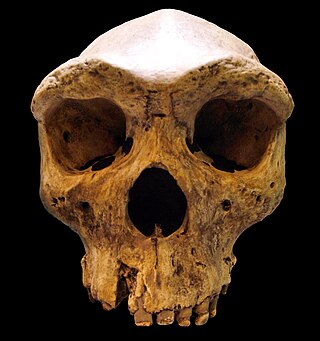
A number of varieties of Homo are grouped into the broad category of archaic humans in the period that precedes and is contemporary to the emergence of the earliest early modern humans around 300 ka. Among the earliest remains of H. sapiens are those from Jebel Irhoud in Morocco, Florisbad in South Africa (259 ka), and Omo-Kibish I in southern Ethiopia. The term typically includes H. antecessor, H. bodoensis, Denisovans (H. denisova), H. heidelbergensis (600–200 ka), Neanderthals, and H. rhodesiensis (300–125 ka).

He County or Hexian is a county in the east of Anhui Province, People's Republic of China, under the jurisdiction of Ma'anshan. It has a population of 650,000 and an area of 1,412 square kilometres (545 sq mi). The government of He County is located in Liyang Town.

Ronald John Clarke is a paleoanthropologist most notable for the discovery of "Little Foot", an extraordinarily complete skeleton of Australopithecus, in the Sterkfontein Caves. A more technical description of various aspects of his description of the Australopithecus skeleton was published in the Journal of Quaternary Science.

Dali man is the remains of a late Homo erectus or archaic Homo sapiens who lived in the late-mid Pleistocene epoch. The remains comprise a complete fossilized skull, which was discovered by Liu Shuntang in 1978 in Dali County, Shaanxi Province, China.

Samu is the nickname given to a fragmentary Middle Pleistocene human occipital, also known as Vertesszolos Man or Vertesszolos occipital, discovered in Vértesszőlős, Central Transdanubia, Hungary.

The Florisbad Skull is an important human fossil of the early Middle Stone Age, representing either late Homo heidelbergensis or early Homo sapiens. It was discovered in 1932 by T. F. Dreyer at the Florisbad site, Free State Province, South Africa.
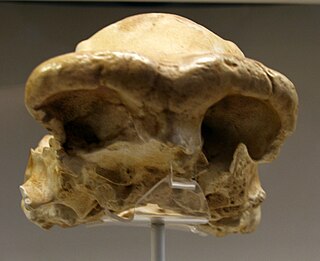
Olduvai Hominid number 9, known as the Chellean Man, is a fossilized skull cap of an early hominin, found in LLK II, Olduvai Gorge by Louis S. B. Leakey in 1960. It is believed to be ca. 1.4 million years old. Its cranial capacity is estimated at than 1067 cm3, the largest value among all known African Homo erectus specimens. OH 9 is significant because the features it carried and its correlation to the species classification it resides in.

Kabwe 1, also known as the Broken Hill skull and Rhodesian Man, is a Middle Paleolithic fossil assigned by Arthur Smith Woodward in 1921 as the type specimen for Homo rhodesiensis, now mostly considered a synonym of Homo heidelbergensis.
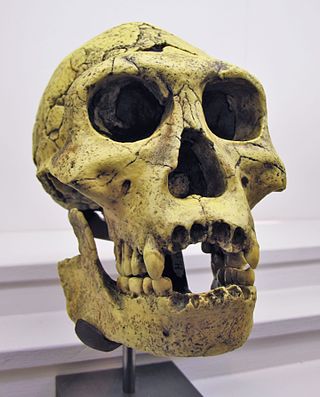
The Dmanisi hominins, Dmanisi people, or Dmanisi man were a population of Early Pleistocene hominins whose fossils have been recovered at Dmanisi, Georgia. The fossils and stone tools recovered at Dmanisi range in age from 1.85 to 1.77 million years old, making the Dmanisi hominins the earliest well-dated hominin fossils in Eurasia and the best preserved fossils of early Homo from a single site so early in time, though earlier fossils and artifacts have been found in Asia. Though their precise classification is controversial and disputed, the Dmanisi fossils are highly significant within research on early hominin migrations out of Africa. The Dmanisi hominins are known from over a hundred postcranial fossils and five famous well-preserved skulls, referred to as Dmanisi Skulls 1–5.

The hominin remains discovered at Sambungmacan are a series of four archaic human fossils assigned to Homo erectus and discovered in Java. The first is the calvarium is Sm 1, the second is a tibial fragment Sm 2, and the third and fourth are calvaria Sm 3 and Sm 4. Laitman and Tattersall (2001) suggested naming Sm 3, the second calvarium in the series, Homo erectus newyorkensis, but later sources do not agree with this taxonomic scheme.
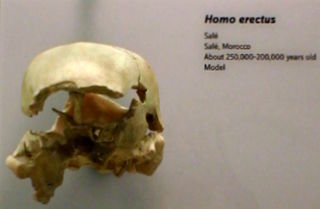
The Salé cranium is a pathological specimen of enigmatic Middle Pleistocene hominin discovered from Salé, Morocco by quarrymen in 1971. Since its discovery, the specimen has variously been classified as Homo sapiens, Homo erectus, Homo rhodesiensis/bodoensis, or Homo heidelbergensis. Its pathological condition and mosaic anatomy has proved difficult to classify. It was discovered with few faunal fossils and no lithics, tentatively dated to 400 ka by some sources.
